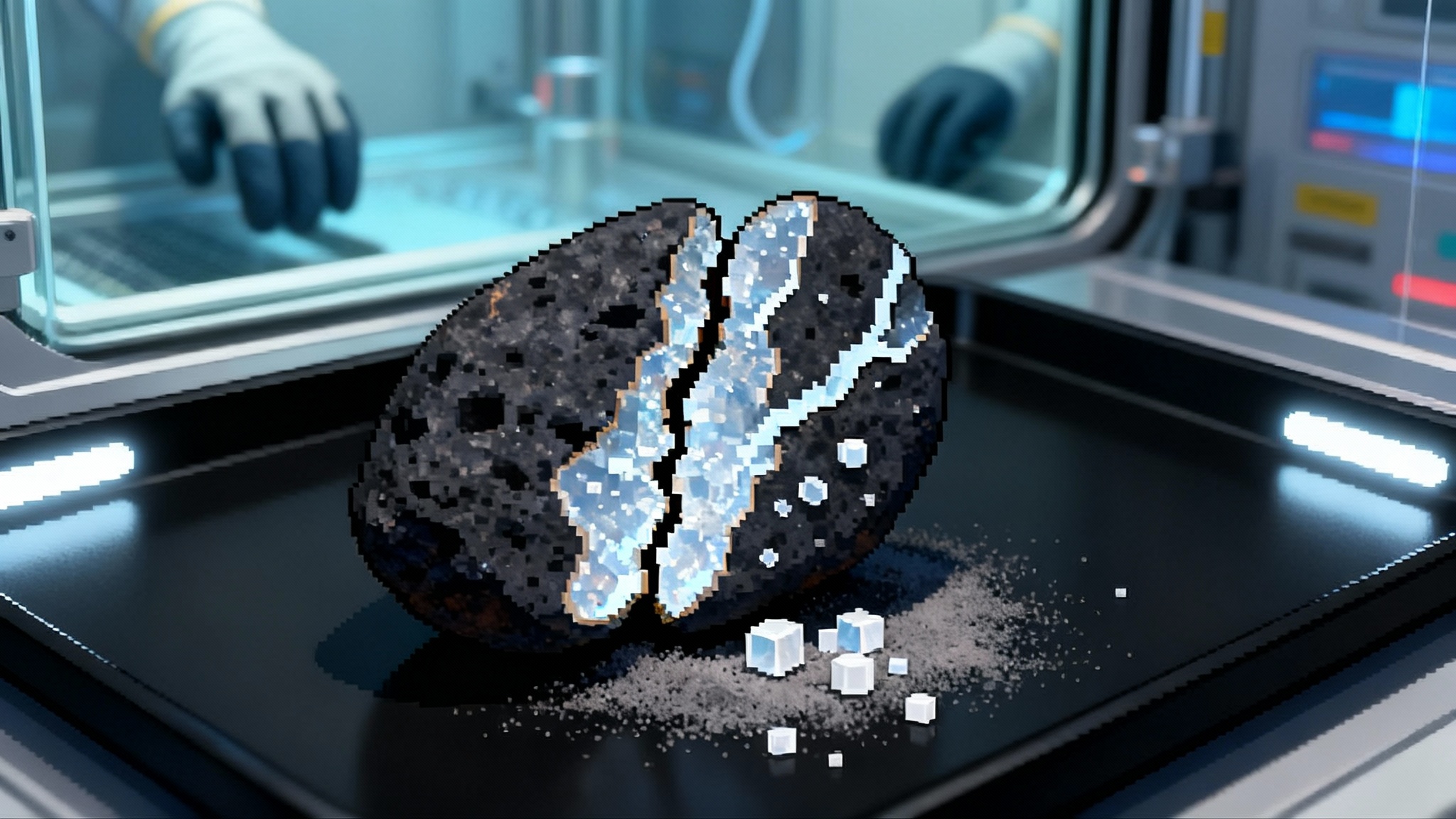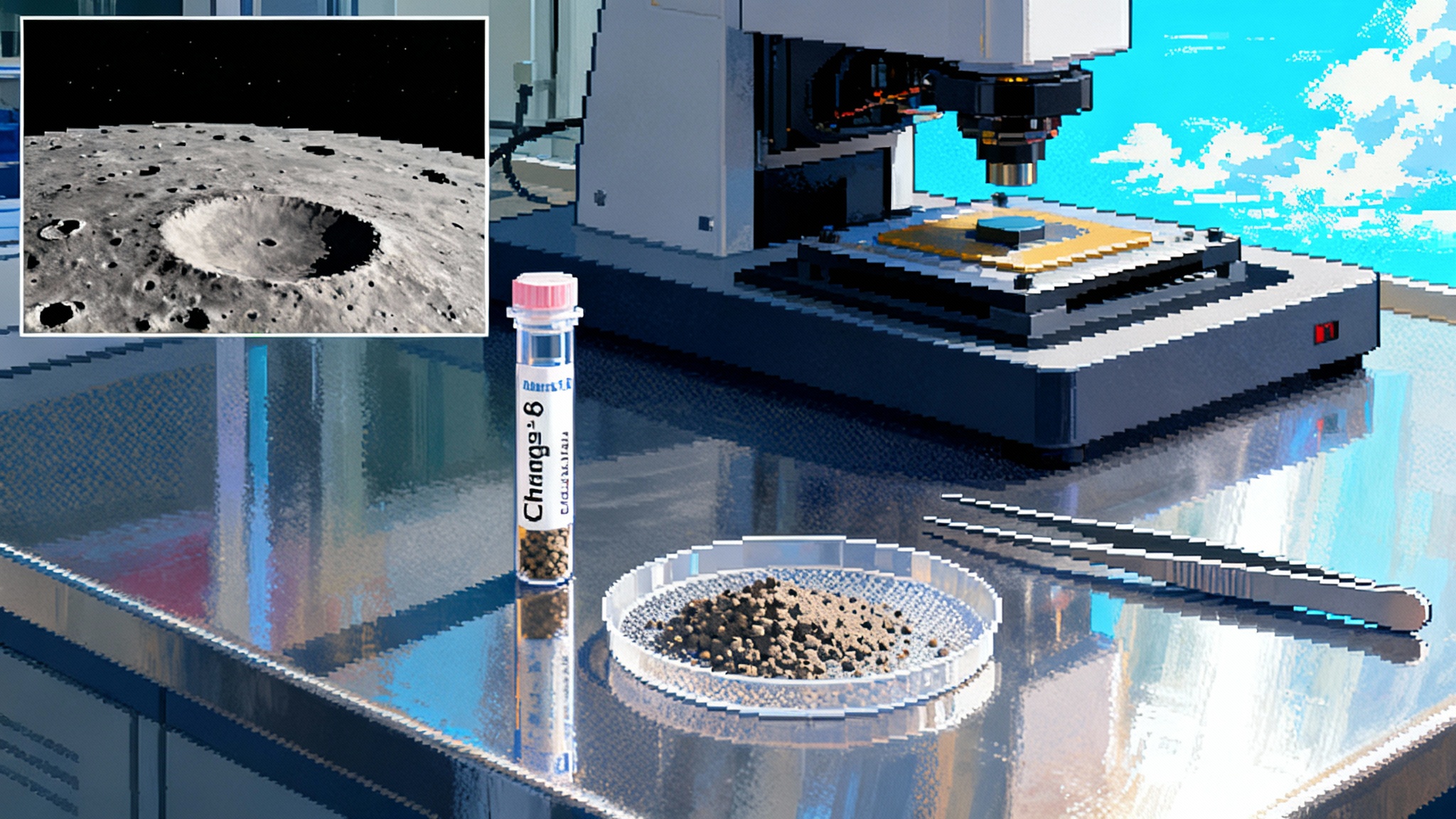Bennu’s Bounty: What the Samples Say About Life’s Recipe
January 2025 analyses of the OSIRIS-REx Bennu sample uncovered soluble organics including amino acids and all five nucleobases, plus evaporite salts formed in ancient brines. Here is what that means for prebiotic chemistry and the missions we should fly next.

What the Bennu papers actually found
On January 29, 2025, two peer‑reviewed studies reset the conversation about how lifelike molecules arise on small worlds. One paper reported ammonia‑rich, nitrogen‑rich soluble organic matter in Bennu grains, including 14 of the 20 protein‑forming amino acids and all five nucleobases that biology uses to encode information. The team also cataloged thousands of additional nitrogen‑bearing species that tend to fall apart or get washed away on Earth. You can read the primary result on ammonia‑rich organics in Bennu.
The companion paper tackled the mineral story. Scientists found an ensemble of evaporite salts locked inside the rock. These include sodium‑rich carbonates, sulfates, chlorides, fluorides, and sodium‑magnesium phosphates that only make sense if liquid water once pooled and slowly evaporated inside Bennu’s long‑vanished parent body. The sequence of salts maps to a classic drying‑out curve, the kind you see in Earth’s salt lakes when brines concentrate over time. The mineral paragenesis tells a simple story with profound stakes. Bennu’s parent body had water, it had salts that trap and shuttle phosphorus, and it had the time to cook chemistry. See the study detailing evaporite salts from ancient brine.
Together, these results give us two ingredients long sought in the same place, at the same time, and in pristine samples. There are abundant soluble organics that look ready to react, and there are salts that can both catalyze and concentrate reactions. That combination moves volatile‑rich asteroids from speculative test tubes to plausible engines of prebiotic chemistry.
Why salt‑rich brines matter for prebiotic chemistry
If you were going to design a chemistry lab to make life’s building blocks from scratch, you would not start on a dry rock. You would want water to dissolve molecules and bring them together. You would also want salts to help the right ones meet and to push the wrong ones apart. Evaporating brines are ideal for both tasks.
- Brines boost concentration. Most prebiotic reactions stall when molecules are too dilute. As water evaporates in a closed pocket or crack, solutes climb in concentration. In Bennu, that concentration process left behind a ladder of salts that match what you see as brine dries and cools. Organics hitch a ride in this system. They stick to salt surfaces, get corralled in microenvironments, and reach reaction‑ready levels that would be impossible in a vast ocean.
- Phosphate becomes available. Phosphorus is crucial for energy transfer and information molecules, but it is often locked in stubborn minerals. Sodium‑rich phosphates are water‑soluble and reactive. Their presence on Bennu indicates that phosphate could have been abundant in the same fluids that soaked the organics, a major boost for building nucleotides and energy carriers.
- pH and redox buffering. Carbonates, sulfates, and chlorides do more than crystallize. They set pH, control ionic strength, and help shuttle electrons. Those parameters decide which reaction paths are open. Bennu’s salts point to moderately alkaline, evaporating waters that would favor certain amino acid and nucleotide syntheses.
- Microreactors everywhere. When brines invade a porous rock, each pore, vein, and fracture becomes a tiny laboratory. The evaporite textures found in Bennu fragments are a geological record of those labs. They imply many cycles of wetting and drying, concentration and crystallization, which are exactly the cycles many prebiotic models require.
How volatile‑rich asteroids cook and concentrate organics
Put the organics and salts together and you get a credible mechanism for making and stockpiling life’s precursors.
-
Start cold. In the outer disk and molecular clouds, ices carry simple reactive molecules like ammonia and formaldehyde. Those ices collect on dust that later accretes into a primitive body. The isotopic fingerprints in Bennu’s organics fit this cold origin.
-
Warm slightly. Short‑lived radionuclides, impacts, and internal friction gently heat the interior of a 50 to 200 kilometer parent body. Ice melts. Water infiltrates and alters olivine and pyroxene into clay minerals, releasing magnesium and iron and making the rock more porous. The brine picks up sodium and other ions from the matrix.
-
Make salts and catalyze. As water moves and evaporates in confined spaces, the salt sequence begins to crystallize. Surfaces of carbonates and phosphates provide catalytic sites. Organics dissolved in the same brine become more concentrated with each wet‑dry cycle.
-
Select and sort. Minerals do not just catalyze reactions. They also select. Layered clays and salt crystals prefer certain molecular shapes and charge distributions. That kind of templating helps explain why complex mixtures produced in space can still show patterns we care about, like amino acids favoring chains that biology can use.
-
Break and mix. Catastrophic impacts later shatter the parent body into rubble piles like Bennu. This remixing spreads the chemistry into boulders and dust. OSIRIS‑REx sampled that rubble and returned a time capsule from the early solar system.
This step‑by‑step path is not a claim that life began on an asteroid. It is a practical sketch of how an asteroid can stock a young planet with kits of ready‑made chemistry. When those kits land in places that add energy gradients and stability, like hydrothermal systems on early Earth, the probability of going further climbs. For planetary context on habitability, see our explainer on the strongest hints of ancient life on Mars, which frames how to weigh these clues across worlds (/mars-ancient-life-2025-explainer).
Curation choices that made the science possible
It is easy to forget that sample handling can make or break this kind of discovery. The Bennu analyses hinged on decisions taken years before the return.
- Inert gas from touchdown to test tube. The OSIRIS‑REx sample canister was connected to a nitrogen purge within hours of landing, and the entire curation workflow at Johnson Space Center runs in gloveboxes flushed with ultra‑pure nitrogen. That protected fragile, soluble salts from Earth’s humidity and prevented modern amino acids from sneaking in.
- Witness plates and contamination knowledge. Engineers placed aluminum and sapphire witness plates in key locations on the spacecraft and in the curation cabinets. Those plates recorded whatever the sample was exposed to at each stage. When you find a molecule in a Bennu grain, you can check if it also shows up on a witness plate. If it does not, confidence rises that it is truly extraterrestrial.
- Materials discipline. Only specific alloys, polymers, and lubricants were allowed anywhere near the sample. Even the custom tools fabricated to finally remove two stubborn fasteners were made from curation‑approved stainless steel. That discipline is why the team could report ammonia‑rich organics and delicate phosphates without caveats.
- Separate storage for pristine fractions. Johnson Space Center isolates aliquots that have never left their nitrogen environment. That creates a bank of untouched Bennu material for future techniques that do not exist yet.
These standards proved decisive. If the salts had sat in humid air for a day, many would have dissolved or transformed. If the organics had seen common lab plastics or skin oils, the signal would have been hopelessly muddied. Instead, the science is crisp.
What this means for the next decade of exploration
The punchline from Bennu is practical. Volatile‑rich asteroids can synthesize and concentrate prebiotic chemistry. That should change where we go, how we collect, and what we fly.
Where to go next
- Ceres for a sample return. Dawn showed carbonates, clays, and brines on the surface and hints of past cryovolcanism. Ceres is the largest water‑rich body in the inner solar system and likely preserves thick evaporite deposits. A well‑designed sample return that targets bright spots and layered terrains could deliver kilogram‑scale suites of salts and organics that make Bennu look like an appetizer.
- Main‑belt comets. Objects like 133P Elst‑Pizarro and 238P Read show comet‑like activity in the asteroid belt. That means ice near the surface and recent sublimation. These bodies bridge the chemistry of comets and asteroids. A smallsat escort plus a touch‑and‑go sampler could capture both surface dust and freshly exposed brine‑altered grains.
- Themis family asteroids. Remote detections suggest surface frost and organics on members like 24 Themis. Sampling different depths across this family would test how far brine processing progressed compared to Bennu.
- Volatile‑rich Trojans as context. NASA’s Lucy will fly by multiple Trojan asteroids this decade. While not a sample return, those encounters will help rank which cold‑formed populations best preserve the ingredients we now know to look for.
For a parallel thread on habitability clues and where to search next, see our Mars overview on the strongest hints of ancient life (/mars-ancient-life-2025-explainer).
How to fly and collect
- Preserve volatiles and salts. Design sample trains that never see humid air and that limit warming above a chosen threshold. A sealed, nitrogen‑charged head like TAGSAM is a good start. Add cold storage for the trip home and continuous inert purge from landing through initial curation.
- Target context, not just quantity. Bennu showed that the sequence of salts is the story. On future missions, map evaporite veins and layers first, then collect short cores that cross those boundaries. Pair each core with a surface sweep in the same geologic unit to tie in space weathering. That approach will also benefit quasi‑moon campaigns such as the Tianwen‑2 quasi‑moon mission (/tianwen-2-kamooalewa-quasi-moon-sample-return-2027).
- Sample diversity on purpose. Make it a requirement to cache separate fractions for organics‑first, isotopes‑first, and mineralogy‑first. That means different containers, different headspaces, and different handling flows tailored to each science goal.
- Build in contamination knowledge from day one. Fly witness plates on the spacecraft and inside the sampler. Pre‑qualify every material that can touch the sample. And archive blanks, atmospheric samples, and tool swabs as part of the returned collection.
What instruments to bring
In situ payloads should be chosen with Bennu’s chemistry in mind. A few tools stand out.
- Vibrational spectroscopy with resolution. A micro‑Raman and a mid‑infrared spectrometer can map carbonates, phosphates, and organics at grain scales. Use them before sampling to select veins and pockets with intact sequences.
- X‑ray diffraction and X‑ray fluorescence. XRD identifies crystallographic phases in evaporites. XRF provides elemental ratios, especially sodium, chlorine, phosphorus, and sulfur, that flag brine histories.
- Wet chemistry microlab for salts and organics. A sealed, single‑use microfluidic cartridge could dissolve tiny chips in ultra‑pure solvent inside the lander, then run ion chromatography for anions and cations and capillary electrophoresis for amino acids. Pair with a small GC‑MS oven with derivatization to lock in chirality and volatility data.
- High‑resolution mass spectrometry. An Orbitrap‑class analyzer or reflectron time‑of‑flight with laser desorption can survey thousands of organic species without ovens. The Bennu organics are soluble and diverse, so soft ionization modes are a match.
- Context cameras and microscopes. Grain‑scale imaging is not a luxury when textures carry the brine story. Plan for sub‑micron imaging of veins and pore networks before and after sampling.
Mission profiles that make sense now
- Ceres Sample Return, focused and fast. A Discovery‑class profile with a small chemical‑mapping orbiter, a short‑lived lander that drills and loads a sealed head, and a direct Earth return. Land on a bright carbonate patch or a layered evaporite exposure. Cache two sealed cores plus surface fines, then leave. The science return would be transformative for origin‑of‑life research. For lift and cadence context, see our preview of New Glenn Mars ESCAPADE (/new-glenn-escapade-mars-preview-analysis).
- Main‑belt comet rendezvous and snatch. Fly a dust collector through the coma during an active phase, then touch down for a brief surface sample at aphelion when activity is low. Return both to compare brine‑altered subsurface grains with fresh outgassed dust.
- OSIRIS‑style samplers with upgrades. Keep the basic nitrogen burst and sealed head approach, but add cold trapping, internal pressure and humidity sensors, and a better mechanism for multiple bites in one site so that veins, matrices, and fines can be captured separately.
Connecting to the origin of life puzzle
Bennu does not show life. It shows readiness. You have soluble, nitrogen‑rich organics that include amino acids and nucleobases. You have salts that deliver phosphate and shape reaction conditions. You have evidence for cycles that concentrate and dry. None of that guarantees the leap to metabolism or replication, but it closes the gap between raw space chemistry and the stocked pantry early Earth likely received.
The bigger picture is sobering in a good way. If this chemistry happens on a rubble pile like Bennu, it likely happens wherever water, rock, and simple organics meet under gentle heat. That makes the delivery of prebiotic kits to young planets common, not rare. The question then tilts from whether ingredients were available to whether environments existed that could sustain the long, messy climb to life. That is a better question for the next decade of exploration.
The bottom line
The early 2025 Bennu results did more than fill a museum vial. They sketched a working recipe. Volatile‑rich asteroids can synthesize and concentrate life’s precursors in tiny rock‑bound laboratories powered by brines. With the right targets, careful curation, and instruments tuned to salts and soluble organics, we can now test that recipe in the places most likely to preserve it. If we do, the next returned sample that clicks into a nitrogen glovebox may not just show readiness. It may show steps on the path from chemistry to biology.








